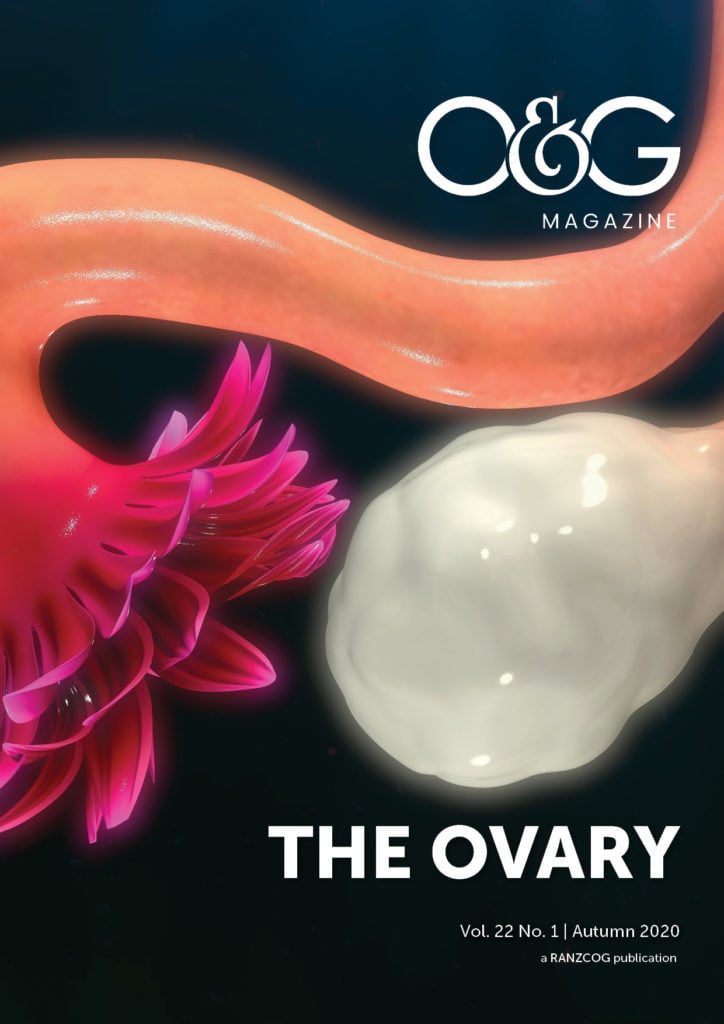The O&G Magazine Advisory Committee has devoted this issue to the ovary in recognition of its particular importance to our specialty.
I imagine most adults would have some understanding of what an ovary is and what it does but probably only think of it when it is associated with a problem such as menstrual disturbance or pain.
It is an undervalued and underrated structure that has such a central role in women’s lives. For such a small structure, it exerts phenomenal power over women’s bodies and their psychological wellbeing. It’s oocytes and the hormones produced by the ovary are essential for reproduction.
The first known use of the word ovary was in 1658 and is derived from the New Latin word ōvārium, meaning egg or nut. It has only been in the last hundred years that the function of the ovary has been understood. Scientific interest and progress in understanding ovarian function and chemistry began early in the 20th century.
Prior to this, there were interesting theories about conception. Clara Pinto-Correia, the author of The Ovary of Eve, gives a fascinating account of seventeenth- and eighteenth-century efforts to understand conception. In the early years of the Scientific Revolution, people struggled to come to terms with the origins of new life, and one theory – preformation – sparked an intense debate that continued for over a hundred years. Preformation theory proposed that organisms develop from miniature versions of themselves.
Oestrone was the first female hormone to be discovered and was isolated from the urine of pregnant women, in 1929, by Edward Doisy from St Louis. In 1935, oestradiol was isolated from the ovary and, soon after, chemists had produced ethinyl oestradiol and diethylstilboestrol. Progesterone was discovered in 1933 and by 1941, Premarin was being manufactured.
Most literature on the ovary are medical texts, papers and dissertations on ovarian function and physiology, as well as conditions of the ovary such as PCOS and cancer, and a number of women have written memoirs about their experiences with conditions such as ovarian cancer and infertility. There is the odd exception, such as Madame Bovary’s Ovaries by David and Nanelle Barash, which is described as a Darwinian look at literature.
The ability to exert control over the ovary has given women freedom over conception and this has coincided with massive social and political changes for women.
In this issue of O&G Magazine, we present an interesting collection of articles, rather than a complete review of the ovary in relation to obstetrics and gynaecology.
There is an overview of basic biology and current research as well as the ovary in early pregnancy and details of an IVF cycle.
‘Exercise and the ovarian hormones’ looks at both the effect of exercise on the ovary and of the ovary on exercise. It is not surprising that most studies on human physiology and sport have been on men.
‘The Pill: a short history’ alludes to the massive social change and improvement in the status of women that was associated with the means to control decisions on fertility and childbirth. Newer and safer versions have followed the original pills and we have a better understanding of the benefits and risks.
Cancer screening and risk-reduction surgery is topical and has received wide media coverage, especially when Angelina Jolie decided to have bilateral mastectomies to reduce her genetic susceptibility to develop breast cancer. The ovary can be seen in a similar light. Genetics of cancer is a developing and rapidly changing area and is discussed in ‘Ovarian cancer risk and how to manage it’.
The article on ‘How to manage a complex ovarian cyst’ is of particular interest to me and discusses the questions most gynaecologists need to consider when receiving such an ultrasound report. Ideally, the reporting sonologist understands the clinician dilemmas, the decisions that will follow such a report and the implications for the women about whom the report is written.
There are also surgical articles on preventing adhesions and a step-by-step guide on laparoscopic ovarian cystectomy.
‘Treating ovarian cancer and life after surgery’ puts a lot of emphasis on quality of life after surgery and the need to counsel women carefully and individualise care and advice taking into consideration factors such as her age and stage of disease.
We hope you find this issue on the ovary both informative and interesting.






Leave a Reply